C.A.A. Savastano's Blog, page 18
May 30, 2017
Improbability Vault update
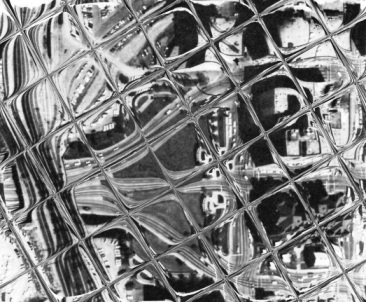
The latest addition to the Improbability Vault is "A Plaza Full of Mirrors" which reviews four different men some have prior claimed were present in Dealey Plaza during the Kennedy assassination. Each claimed person is subjected to verifiable evidence placing them elsewhere. #JFK https://www.tpaak.com/a-plaza-full-of-mirrors/
May 22, 2017
Primary Evidence Collections update

The Assassination Archives and Research Center has accepted CIA pseudonym research from C.A.A. Savastano. It can be found at the AARC's "Select CIA Pseudonyms" listing. http://aarclibrary.org/2365-2/
The featured pseudonyms can also be found with additional cryptonym and alias research here in the Primary Evidence Collections: https://www.tpaak.com/cia-cryptonyms-and-pseudonyms
May 15, 2017
Primary Evidence Collections Update

A notable document supports Manuel Ray a Cuban exile leader planned to betray the CIA. It reveals despite his abundant funding and support provided by CIA officials, he attributed his group's failures to the Agency. This document and a brief statement of his background are offered for your review. #JFK #Cuba https://www.tpaak.com/related-individuals-of-note
February 20, 2017
Primary Evidence Collections update

For your review are four new cryptonyms Carmine Savastano assisted documenting at the Mary Ferrell Foundation (LNERGO, BKHERALD, LNAGON, QJWIN). They reveal code names used in the evidence to represent the FBI, CIA, the Bureau of Narcotics and Dangerous Drugs, and a foreign assassination operative Jose Marie Andre Mankel. #CIA #Cryptonym http://tpaak.com/cia-cryptonyms-and-pseudonyms http://www.maryferrell.org/php/cryptdb.php
February 13, 2017
Primary Evidence Collections update
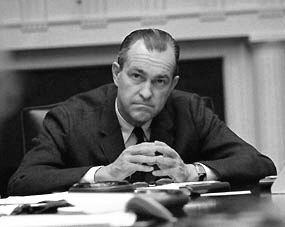
CIA Officer Richard M. Helms
Three documents are presented for your inspection. An internal message sent using pseudonyms (code names) between the CIA's Mexico City Chief of Station Winston Scott and Deputy Director for Plans Richard Helms. The cable reveals in the days following President Kennedy's assassination officials internally supported the possibility of a conspiracy. A position Helms would consistently deny and seek to dispel after the President's Commission Report. Two other documents identify Helms as Fletcher Knight and Scott as Willard Curtis. #JFK
http://tpaak.com/related-individuals-of-note
February 6, 2017
The Accidental Shot Claims

An example of the AR-15 RIFLE Associated with these claims
The idea that President John F. Kennedy was allegedly shot accidentally by Secret Service Agent George Hickey was most recently presented in the film "JFK: The Smoking Gun". Bonar Menninger presented a former incarnation of the story in his book "Mortal Error: The Shot That Killed JFK". However, the story was offered first to the media and then to the Federal Bureau of Investigation decades earlier by gunsmith Howard Donahue. The story when viewed with historical perspective and evidence has serious verifiable issues.
Howard Donahue contacted Federal Bureau of Investigation Special Agent Dudley Hodgson February 19, 1977. Donahue informed the Bureau agent that "... since the assassination of President Kennedy, he has been gathering bits and pieces of information..." Donahue told the Bureau a friend at White Laboratories contacted him to assist conducting tests of a prototype weapon similar to the Kennedy murder weapon. This offered Donahue a chance to speak with Secret Service and Bureau agents regarding the issue. Donahue "...continued his efforts to uncover the true circumstances of the assassination and during the course of time arrived at the theory that while Lee Harvey Oswald did, in fact, fire the 6.5 mm Carcano, the shot that blew off half of the President's head was fired by a high velocity small caliber weapon such as 223 Caliber M-16 typical of the weapons then being used by the Secret Service."i
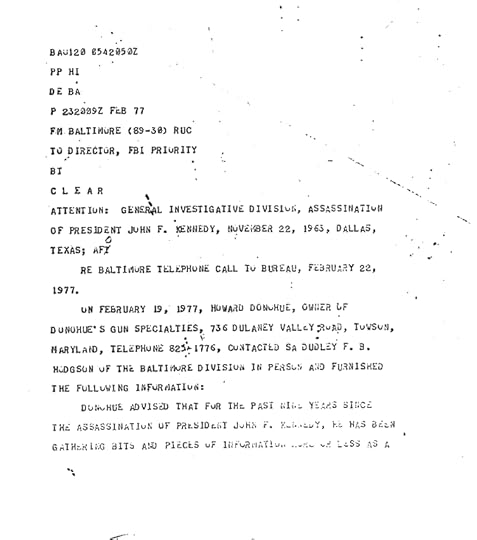
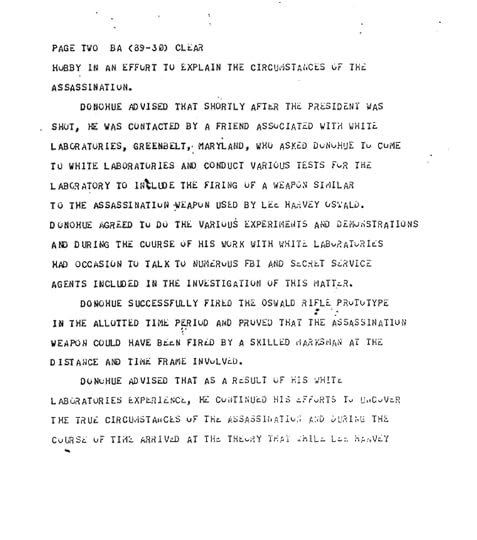
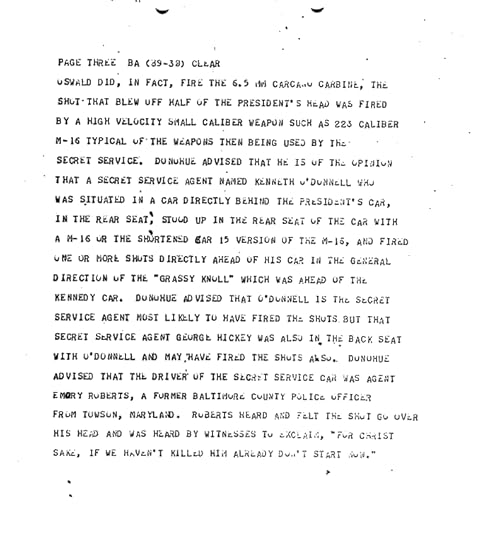
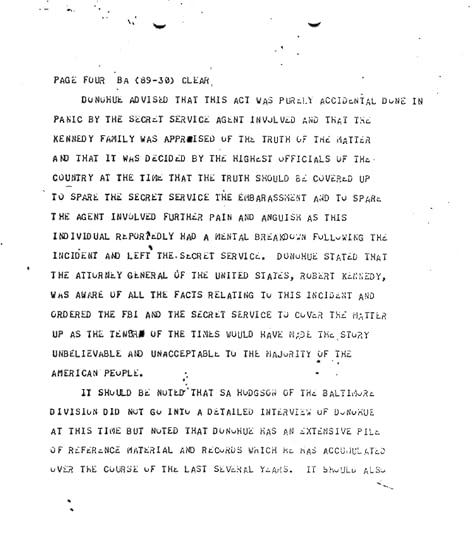

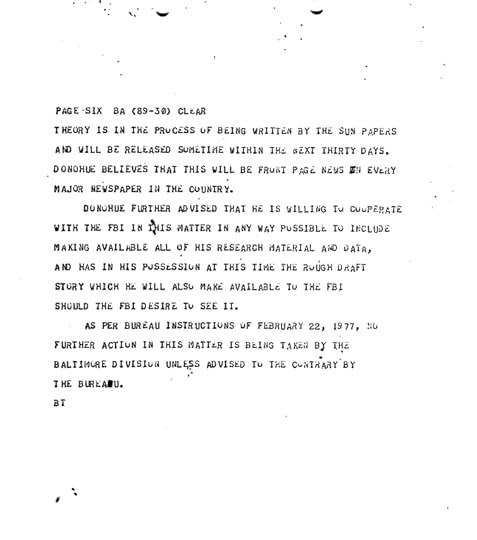
Donahue "...is of the opinion that a Secret Service Agent named Kenneth O'Donnell who was situated in a car directly behind the President's car with a M-16 or the shortened AR 15 version of the M-16, and fired one or more shots directly ahead of his car in the general direction of the "Grassy Knoll" which was ahead of the Kennedy car. He further stated "...that O' Donnell is the Secret Service agent most likely to have fired the shots but that Secret Service agent George Hickey was also in the back seat with O'Donnell and may have fired the shots also."ii The story presents a significant problem during its first incarnation; Kenneth O'Donnell seated on the left jump seat was not a Secret Service agent but a Kennedy special assistant and notably was unarmed. We can safely put aside the initial primary suspect as a case of mistaken identity. This episode of changing suspects represents the first verifiable mistake that occurred.
Donahue asserts that Secret Service agent Emory Roberts "...heard and felt the shot go over his head and was heard by witnesses to exclaim "For Christ sake, if we haven't killed him already don't start now." Yet Roberts never confirms this statement. He never mentions it in testimony, nor makes any public statement alluding to the claim offered by Donahue. No verifiable group of witnesses around Roberts is offered to confirm this idea and no evidence is offered to support it occurred. Without verification, it is seemingly just rumor.

White House SPECIAL ASSIsTANT
Kenneth O' Donnell
When Donahue had later realized O'Donnell was not a Secret Service agent, he settled upon Secret Service Agent George Hickey. Hickey emerged as Donahue's new prime suspect because he was seated behind O'Donnell in the left rear seat and employed a larger weapon near the time of the shots. Donahue offers some contending and imperfect trajectory ideas similar to some officials, and he seemingly attempted to fit the evidence to his idea.
A lack of support from all nearby witnesses is a further problem. Secret Service agents were positioned on all side running boards and were seated inside the car. Two Presidential aides were also in the car and none of these people support their vehicle was the origin of a shot fired. This includes Secret Service Agents Samuel Kinney, Emory Roberts, George Hickey, Glen Bennet, Clinton Hill, William McIntyre, John Ready, Paul Landis, and Special Assistants to the President Kenneth O' Donnell and Dave Powers.iii iv v vi vii viii ix x xi xii No immediate eyewitnesses within or outside the car indicates a shot fired by Hickey. Nor does any large group of witnesses in the crowd assert observing a shot fired at this location. Donahue's story has no repeated eyewitness statements to support it. Secret Service Agent William McIntyre stated explicitly "...no shots were fired by any agent."xiii
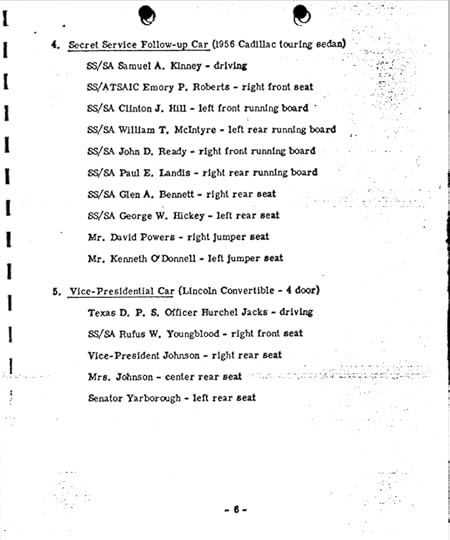
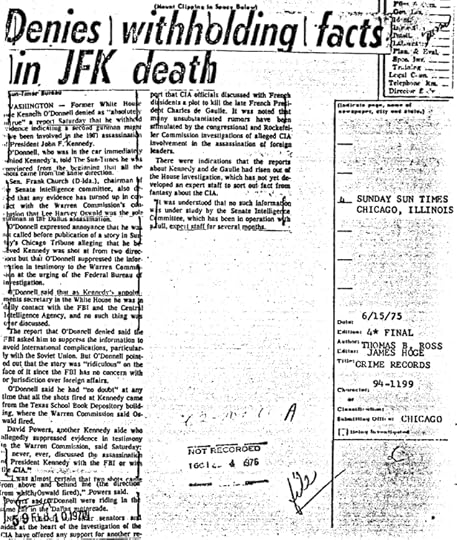
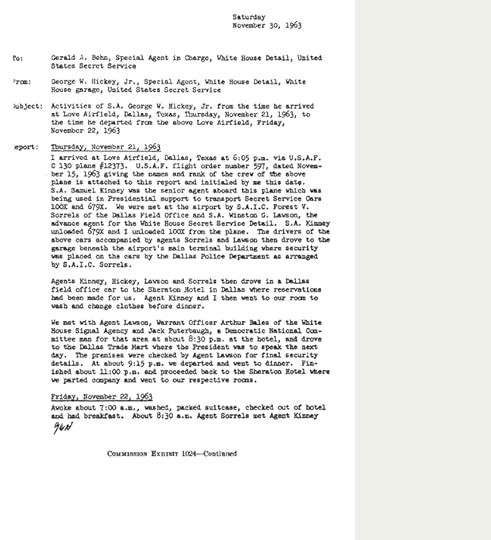
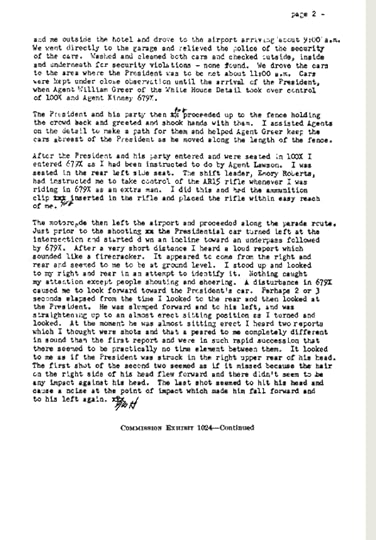
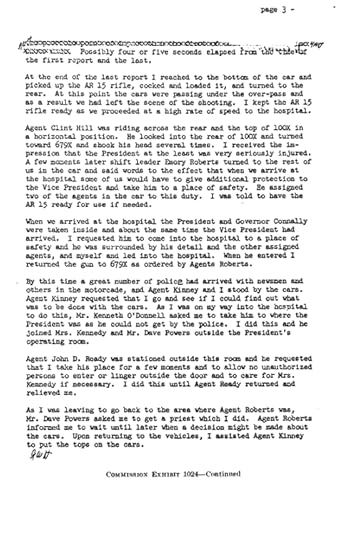

Additionally, none of the four motorcycle officers flanking this portion of the motorcade offer statements of a shot fired by someone in the follow up car. Two of these Dallas police employees offer the President's Commission testimony, Officers Bobby Hargis and B.J. Martin.xiv xv The remaining nearby motorcycle officers subsequently made statements to the Federal Bureau of Investigation before the House Select Committee investigation began. Jim Chaney and Doug Jackson also never mention a shot fired from the car following the President's vehicle nor place the shot's origin near their immediate vicinity.xvi xvii
Agent Hickey retrieved the single AR-15 rifle from between the seats after the President was struck by gunfire. "All the occupants of the follow-up vehicle indicated they believed the shots were fired from the 'right rear' and Hickey stood up in the vehicle and faced in that direction. No verifiable shots were fired from the follow-up vehicle."xviii Fourteen eyewitnesses all support no shots were fired by Hickey from the left rear seat and he faced in the wrong direction to fire the shot alleged by Donahue.
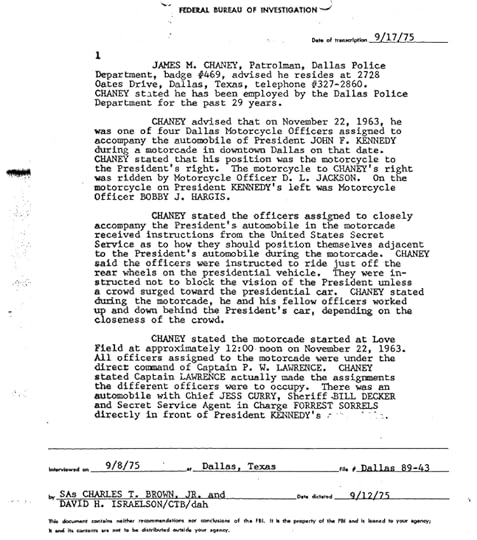
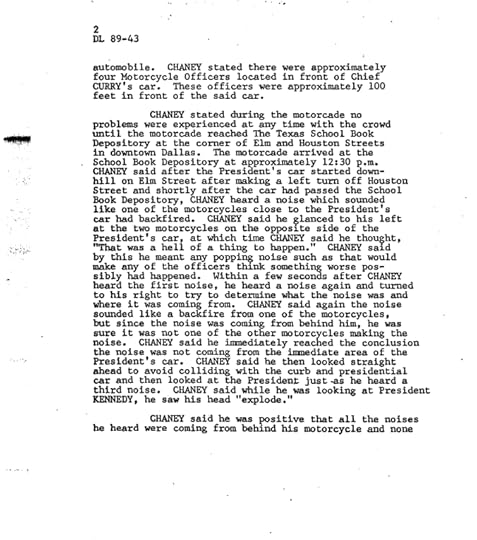
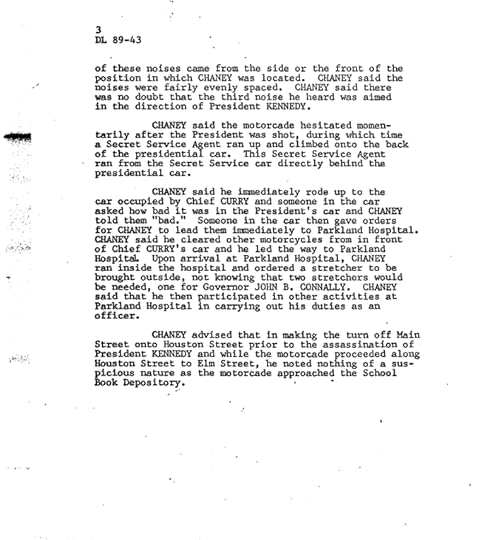
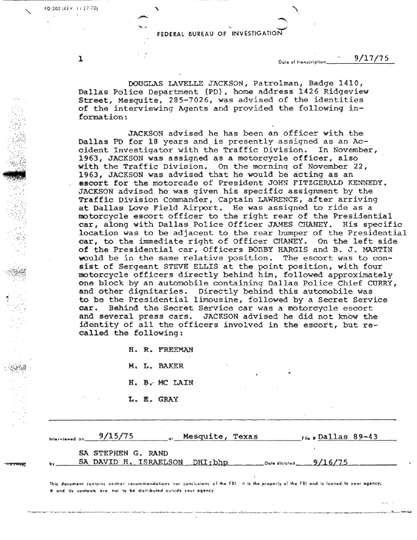
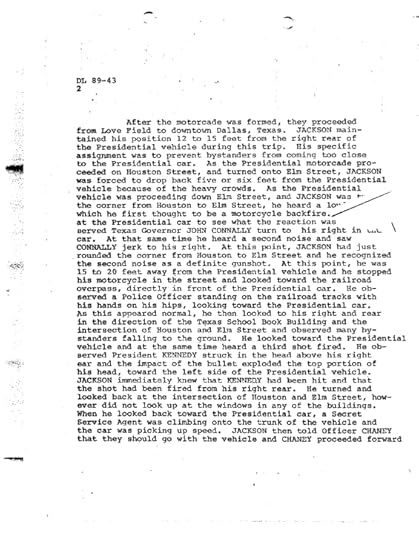
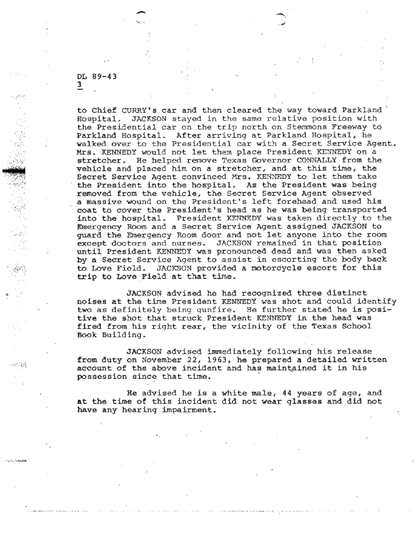
The Bureau file additionally states "A review of the Zapruder film confirms that at the time of the head wound was inflicted, the grassy knoll was not 'ahead of the President' (as Donahue claimed) but at an elevated direct right angle to the Presidential vehicle. Additionally, the position of the President's head, turned to the left and slumped on his chest negates (Donahue's) theory of the fatal bullet being fired from the left rear." Officials also noted that the wounds on the President "are not consistent with the characteristics of a wound inflicted by a bullet fired from an AR-15."xix
The problems do not end with witnesses, ballistic interpretation, and mistaken identities. Perhaps the largest problem associated with this theory is the suggested large conspiracy required to cover-up the asserted shot. Donahue claimed, "...the Kennedy family was apprised of the truth of the matter and that it was decided by the highest officials of the country at the time that the truth should be covered up to spare the Secret Service the embarrassment..." This claim is highly improbable, it makes no sense that the Kennedy family would agree to such a deception. Donahue also claimed the cover up was created to "...spare the agent involved further pain and anguish as this individual reportedly had a mental breakdown following the incident and left the Secret Service." It is highly doubtful Kennedy loyalists and varied different officials would conspire to hide the true circumstances of his death if it was an accident. It is also highly doubtful they would never have been discovered or betrayed and would have risked their legacies on such a tale.
Donahue further asserted, "...The Attorney General of the United States, Robert Kennedy, was aware of all the facts relating to this incident and ordered the FBI and the Secret Service to cover the matter up as the tenor of the times would have made the story unbelievable and unacceptable to the majority of the American people."xx This seems a contrived attempt to buffer the natural doubts that should occur at the mention of such a problematic story. Indeed officials will underestimate the perception and understanding of the American people, but in this case, reasonable doubts stem from the lack of evidence.
It is also improbable that Robert Kennedy would conspire to protect the very agency that Donahue claims is responsible for his brother's death. To imagine that Robert Kennedy would orchestrate a large conspiracy and rely on J. Edgar Hoover, perhaps his greatest political enemy to help conceal it, offers a misunderstanding of the way in which our government functioned. Donahue's other motivations as well may be reflected by his claim to the Bureau that once featured in the press his story "...will be front page news in every major newspaper in the country."

AN EXCERPT FROM SECRET SERVICE AGENT GEORGE HICKEY's Legal Statement THAT SUPPORTS HE was unarmed During the Shots.
The Bureau assumed that was the end of the matter and that Donahue's claims would be dismissed upon their own lack of merit. Donahue's story however did not appear nationwide but featured in the Baltimore Sun. In 1992, Bonar Menninger wrote a book supporting Donahue's theory, and Donahue died seven years later. Agent George Hickey finally tired of being labeled the accidental murderer of President Kennedy sued Menninger and his publisher. The case was reportedly settled out of court.xxi Yet so much time had passed, there was no legal remedy to correct these evolving claims.
Subsequently, George Hickey died and could no longer sue those who wished to present the old improbable theory with a modern spin. Enter the Reelz network who produced the film "JFK: The Smoking Gun", which lacks the definitive proof its name would imply. The film adds to Donahue's improbable claims because he also believed the diameter of the President's wound supported it was not a Carcano bullet. Yet as some medical experts on both sides of the case have often stated it was a gaping wound requiring interpretation and thus mistaken ideas could result. Donahue while a gun expert was not a medical expert and his access to primary evidence during the time he created his ideas was limited. A feasible conspiracy based on substantial evidence is possible. Yet the ideas of Howard Donahue no matter in what medium they exist remain unproven.
Sincerely,
C.A.A. Savastano
TPAAK Facebook
References:
i. Federal Bureau of Investigation, House Select Committee on Assassinations, Administrative Folder I6: Assassination Matters Volume VIII, Baltimore telephone call to Bureau, February 22, 1977, pp. 2-3
ii. Ibid
iii. President's Commission Hearings, Volume XVIII, Commission Exhibit 1024, Letter from the
Secret Service to the Commission with attached statements, Statement of Samuel Kinney, November 30, 1963, p. 731
iv. Ibid, Statement of Emory P. Roberts, November 29, 1963, pp. 734-735
v. Ibid, Activities of George A. Hickey, June 11, 1964, pp. 762-763
vi. Ibid, Protective Assignment of Special Agent Bennett, November 23, 1963. p. 760
vii. Assassination Records Review Board, Medical Document 50, Hill Warren Commission Testimony, March 9, 1964, pp. 134-139
viii. Pres. Com. Hearings, Vol. XVIII, Com Ex. 1024, Statement of John Ready, November 22, 1963, p. 749
ix. Pres. Com. Hearings, Vol. XVIII, Com Ex. 1024, Statement of Paul E. Landis, November 30, 1963, p. 754
x. Pres. Com Hearings, Volume VII, Testimony of Kenneth P. O' Donnell, p. 448
xi. Ibid, Affidavit of David F. Powers, p. 473
xii. FBI, President's Commission Liaison file, Warren Commission Headquarters File 62-109090, Section A6, Chicago Sun Times , "Denies withholding facts in JFK death", June 15, 1975
xiii. Pres. Com. Hearings, Vol. XVIII, Com. Ex. 1024, Statement of William McIntyre, November 29, 1963, p. 2
xiv. Pres. Com. Hearings VI, Testimony of Bobby W. Hargis, P. 295
xv. Ibid, Testimony of B. J. Martin, p. 289
xvi. House Select Committee on Assassinations, Administrative Folder I-8, JFK Motorcycle Officers Interviews, Statement of Douglas Lavelle Jackson, September 17, 1975
xvii. Ibid, Statement of James M. Chaney, Sep. 17, 1975
xviii. FBI, Headquarters file 62-109060, Section 189, Memorandum from J.S. Peelman to Mr. Gallagher, February 25, 1977, p. 3
xix. Ibid
xx. FBI, HSCA, Admin. Folder I6: Volume VIII, Baltimore telephone call to Bureau, February 22, 1977, p. 4
xxi. Peter Mucha, (November 12, 2013), Shooting holes in theory that a Secret Service agent killed President Kennedy, Philadelphia Inquirer, philly.com
January 30, 2017
Two Princes And A King on Notable list for 2016
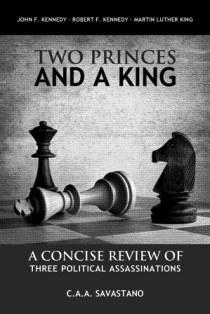
We are proud to announce our Editor Carmine Savastano's book is among the notable books of 2016 featured at the Mary Ferrell Foundation. #JFK http://www.maryferrell.org/pages/Featured_2016_Books.html
January 21, 2017
Primary Evidence Collections update
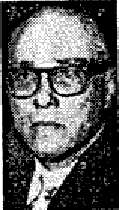

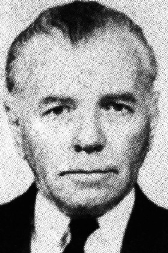
Three new CIA Security files for your review, the first is the file of Cuban anti-Castro exile leader Manuel "Tony" de Varona Loredo, the second regards Mafia leader Meyer Lansky, and the final documents are related to the business group Guy Banister Associates, Inc. #JFK #CIA
http://tpaak.com/cia-security-files
January 9, 2017
Exiled Cuban Crusaders

Major Pedro Diaz Lanz Chief of the Cuban Air Force in 1959
(Diaz Lanz is on the far right)
The United States government, its military, and intelligence agencies considered Fidel Castro's Cuban regime a preeminent threat. The Communist stronghold was located at the front lines of the Cold War and positioned far too close for the taste of American officials. Seeking to overthrow Castro led some American leaders to ignore potential blowback and engage unreliable and criminal groups to see their desires fulfilled. Hundreds of Cuban exiles of interest to the United States seemed committed to the goal of deposing Castro; among them were the Diaz Lanz brothers, Pedro and Marcos.
In 1926, Pedro Luis Diaz Lanz was born in Havana and his academic education was complete by 1944. He was trained and worked as a commercial pilot and began supplying weapons to anti-Batista rebels who supported deposed President Carlos Prio Socarras. According to Central Intelligence Agency files, he went into exile the first time in 1953 when he arrived in Miami to work in local restaurants. In 1955, Cuban dictator Fulgencio Batista granted amnesty to all Cuban exiles and Diaz Lanz rushed back to Cuba. Once arriving within his native land Pedro wasted little time before joining Fidel Castro's 26 of July rebel group to "...ferry arms for Castro". Pedro was additionally "suspected of operating as a courier for Castro from a base in Fort Lauderdale, Florida and is believed to have made trips by plane...to Kingston (Jamaica) from Fort Lauderdale via Cuba and Haiti." Eventually in 1958 Diaz Lanz went to Castro and his forces in the Cuban mountains, and in August he was made Chief of the 26 of July Air Force.
In April of 1959 it was rumored that Pedro Diaz Lanz was among the noted Cuban officials "...whom Raul Castro planned to eliminate because he considered them rightists who were unsympathetic to him." He was among the leaders in danger of arrest for resisting the Communist influence that came to dominate Cuba's armed forces. "...Raul Castro ordered Subject (Pedro Diaz Lanz) to arrange aircraft for a secret flight of selected officers to the military prison on the Isle of Pines." Pedro retained his post until his defection in 1959 when he fled Cuba by plane. Thus began his second exile. Pedro after his arrival in the United States began to gain attention by testifying against the Communist led government in Cuba to the American Congress while also decrying its tactics within the media. Yet while Pedro sought publicity and renown, his younger brother Marcos was feasibly more concerned with financial enrichment.
Marcos Jose Diaz Lanz was born in 1928 and seemingly shared his brother Pedro's revolutionary ideals but not his taste for politics. While Pedro was delivering arms to rebels, Marcos owned the Stanley Window Manufacturer Company in Havana and was a subordinate of his brother in Cuba's air force. Diaz Lanz held this business until January of 1959 when political situation in Cuba began to accelerate. Once his brother Pedro had defected to avoid his imminent arrest, Marcos reached out to secure his escape from Cuba as well. CIA Chief of Western Hemisphere Division J.C. King sent a memo to confirm a request for official assistance to evacuate Marcos from Cuba in July of 1959. When the CIA debriefed Marcos, he mentioned having potential operational assets among disaffected military in Cuba the Agency might use. He also stated being in contact with various exiles in different anti-Castro groups that included exile leaders Tony Varona and later revealed Castro collaborator Eloy Gutierrez Menoyo and his group the Second National Front of Escambray (SFNE). Despite the island wide fallout from Menoyo's actions, the brothers did not wish to accept that Menoyo was pro-Castro. Marcos would soon take up his brother's penchant for running arms but did not limit himself to merely revolutionary forces as clients.
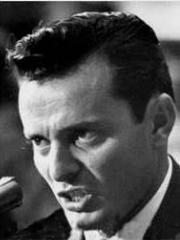
Pedro Diaz Lanz Testifying before the US Congress
Following the Diaz Lanz brothers arrival in the United States they "...began making plans for maintaining their contacts in Cuba and for organizing a small group of exiles here for the purpose of the ultimate overthrow of the Castro regime." "They did not want to be identified with any of the existing anti-Castro groups and stated they resist any groups bearing the Batista taint...They claimed in existence a large following in Cuba in the military and political circles, in labor organization, in the government, and in the Catholic Church, who were only uniting for guidance and direction." Months following his defection Pedro Diaz Lanz and his brother Marcos conducted a leaflet drop by plane of anti-Castro material over Cuba. The Castro government condemned this act"...as a bombing of Havana." Yet the group operations were "short lived, and on 8 December 1959 Marcos Diaz Lanz reported the so called "group" no longer existed. The split occurred due to differences of vision regarding their plots against the Castro government. The brothers then began to work alongside "...elements which contemplated the ultimate formation of junta comprised of the following: Carlos Marquez Sterling...Antonio de Varona...Sanchez Arango..." and "Emilio Nunez Portuondo..." The brothers with some of their allies further devised forming a nonprofit to aid their ventures against Cuba and fund their group's activities.
"On February 13, 1960, Major Pedro Diaz Lanz declared that the Cuban people would be liberated in 1960 and that Fidel Castro would tried as a traitor for joining the International Communist conspiracy. Diaz Lanz and Dr. Rafael Garcia Navarro...reported the formation of the Cruzada Constitutional Cubana (CCC- Cuban Constitutional Crusade) of which Pedro Diaz Lanz was the recognized leader...the crusade was said to have an underground of 4,000 within Cuba...ample resources." Diaz Lanz promised "...the CCC will fight against Communist aggression...The Cuban people will be liberated in 1960." Yet Pedro Diaz Lanz disputed the press release with his message because Lanz believed Dr. Garcia had misrepresented and embellished the facts...because of Diaz Lanz' inadequacy in understanding and speaking the English language. Apparently, this was not an organization but a one-man crusade --- a name adopted by Pedro Diaz Lanz...to conduct his individual activities. Anyone striving for the overthrow of Castro was welcome to cooperate under this banner but it was not intended that is should be an organization with formal registered members." Pedro it seemed wished for less formal associations under his banner to garner the press and public attention for his personal crusade.
Pedro Diaz Lanz also had associations with some CIA sponsored paramilitary groups that include Operation 40. Yet Cuba remained firmly in Castro's grip decades beyond 1960 despite the ambitious declarations of Diaz Lanz. Most exiles disregarded the CCC because the Diaz Lanz brothers used various individuals formerly associated with Batista the deposed Cuban dictator. Eventually Pedro and his followers joined the Frente Revolucionario Democratico (FRD) a large conglomerate of multiple exile groups supported by the CIA.
While Pedro was garnering press and financial support Marcos on the advice of a lawyer went to the American Embassy in Mexico City to request a US resident visa. This action violated his prior agreed parole into official custody. Two months later, he was still awaiting their response in Mexico. The Embassy's Consul sent a telegram for immediate action and stated that "Diaz Lanz feels he was 'milked for information' by U.S. Intelligence organizations and then tossed aside." Agency Officer J.D. Esterline noted that Diaz Lanz appeared to the Consul "...to be 'souring' on the U.S." Marcos finally was able to reenter the United States with extensive official aid.
However, by 1962, the Diaz Lanz brothers' grand declarations had fallen short and they began to resent and blame the Kennedy administration for not giving them further support. Pedro became "...disgruntled with the policies of American officials regarding Cuba...anti-Kennedy propaganda was edited and distributed by him. The ideas expounded were in tone with his conversations to the effect that Kennedy and most of his administration were Communists and were betraying Cuba and the Cubans as well as the citizens of the United States." Due to the reversal against American officials, the CIA advised the Department of the Army to cease any interest in the Diaz Lanz brothers for official use. Several failed deals, aborted raids, and lackluster public support had dampened Pedro's expectation for success in the coming year.
When multiple planned raids were disrupted in July of 1963, it subsequently created misplaced personal dissension among the brothers. Pedro and Marcos had enlisted the aid of mercenary Frank Sturgis aka Frank Fiorini to undertake further aerial raids. Despite the precautions taken, the Federal Bureau of Investigation was able to stop them from making any progress. Pedro stated the FBI told "...him he was under 24-hour surveillance and that whatever he had in mind he might as well forget. They advised him to go home to bed, which he did. When Marcos heard the story he accused Pedro's wife, Tania, and/or Pedro's Father-in-law of informing the FBI as they had done in the past. Marcos was very angry over the abortive operation and went so far as to wonder aloud whether Pedro himself had notified the FBI. Marcos said that Pedro had done everything else to scotch all their plans, including incurring the wrath of the U.S. Government with the publication of the anti-administration propaganda leaflet." Yet it was more likely the information reports Frank Sturgis was giving the CIA that allowed the FBI to prevent their planned raid. Officials noted the Diaz Lanz brothers we both keeping out of official sight by August of 1963.
November 3, 1963 Pedro Diaz Lanz made several incendiary comments at a public meeting. Among the most inflammatory were accusations of President Kennedy being a Communist, supporting Communist governments, and supported individual Communists but would not recognize the anti-Castro junta that was anti-Communist. Pedro also declared American state visits by Communist governments further proved his allegations. He also blamed the Kennedy administration for the overthrow of the South Vietnamese President Diem.
Marcos continued his arms dealer business under the alias "Pedro Garcia" in 1964 and was a prior member of the "Ultra-Rightist group called 'Minutemen' in Yalaha, Florida." Marcos using his Garcia alias "...stated if Lyndon Johnson were reelected President, this group planned to revolt in an armed insurrection against the United States government. Garcia bragged that he had provided the arms for the above revolt." A final CIA document regarding Marcos and his claims states "Diaz talked freely about the election results which by that time indicated President Johnson had been elected...As the margin of votes for Johnson increased, Diaz became more and more excited. Diaz criticized Johnson very severely and referred to him as a SOB. He said that it was becoming obvious "they" would have to go and fight in the streets because "they" were unable to accept the Johnson Government. Diaz did not clarify who the "they" were, but it was understood to mean the Minutemen, received a definite impression that Diaz himself was deeply involved in action contemplated...Diaz made some reference fact that the U.S. would be far better off if Johnson were dead..."
After multiple exiles, broken promises, unrealistic expectations, and failed operations Pedro and Marcos Diaz Lanz were embittered toward the United States and its leadership. By 1963 dozens of other Cuban exiles brought to the United States would similarly turn upon their former sponsors when the Communist government of Cuba failed to be overthrown. How far would some exiles go to seek revenge for a homeland that was never reclaimed?
Sincerely,
C.A.A. Savastano
References:
i. House Select Committee on Assassinations, Segregated Central Intelligence Agency file, Microfilm Reel 6: DeTorres-Diosdado, Folder M- Diaz-Lanz, Pedro, Julio, Biography of Pedro Diaz Lanz
ii. Ibid, Memo for Mr. G. Harvey Summ, Subject: (A) Pedro Luis Diaz Lanz; (B) Marcos Diaz Lanz, December 24, 1963
iii. HSCA, Seg. CIA file, Microfilm Reel 6, Bio of Diaz Lanz
iv. Ibid, Bio Info Marcos Diaz Lanz, (n.d.)
v. HSCA, Seg. CIA file, Microfilm Reel 6, Folder J- Lanz Marcos Diaz, Confirmation of Verbal Request for TSS Assistance in the Evacuation from Cuba of Marcos Diaz Lans (sic), July 31, 1959
vi. HSCA, Seg. CIA file, Microfilm Reel 6, Folder J , Lanz Marcos Diaz, August 5, 1959
vii. HSCA, Seg. CIA file, Microfilm Reel 6, Folder I, Lanz Marcos Diaz, Memo for H. G. Summ, p. 3
viii. Ibid, pp. 3-4
ix. HSCA, Seg CIA file, Microfilm Reel 6, Folder M, Diaz-Lanz, Pedro, Julio, Bio of PDL
x. Ibid, Folder I, Lanz Marcos Diaz, Memo for Rudolph Gomez fromJ. D. Esterline, March 7, 1960
xi. Ibid, Memo for H.G. Summ, p. 4
xii. Ibid, Subject Abortive Air Strike and Leaflet Raid on Habana, July 20, 1963
xiii. Ibid, Memo for H.G. Summ, p. 5
xiv. HSCA, Seg. CIA file, Microfilm Reel 6, Folder M, Diaz-Lanz, Pedro, Julio, Accusations made by Pedro Diaz Lanz, December 14, 1963
xv. Ibid, Folder I, Lanz Marcos Diaz, Memo to FBI on Marcos Diaz Lanz, (n.d.)
xvi.
Ibid, Folder I,
Lanz Marcos Diaz, Redacted Transcript of Comments made by Marcos Diaz Lanz, (n.d.)
xvii. Ibid, Subject: Marcos Diaz Lanz, Planned Insurrection of Minutemen in Florida area, 1964
December 30, 2016
Primary Evidence Collections Update

Richard Scully Cain
Richard S. Cain was a Police Officer, Mafia associate, Sherriff's Investigator, CIA and FBI informant, and Cuban exile contact. One CIA document offers his claims that the Fair Play for Cuba Committee had a secret meeting to discuss the assassination of JFK. The question is what purpose Cain served in attempting to lay the blame at the feet of the FPCC. #JFK #Evidence http://tpaak.com/related-individuals-of-note



